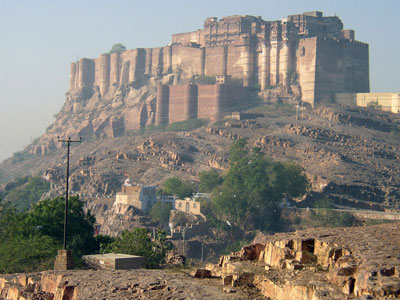Jodhpur Travel Guide:

Introduction
Jodhpur is the second largest city in the Indian state of Rajasthan. It is located 335 kilometres (208 mi) west from the state capital, Jaipur. It was formerly the seat of a princely state of the same name, the capital of the kingdom known as Marwar. Jodhpur is a popular tourist destination, featuring many palaces, forts and temples, set in the stark landscape of the Thar desert.
The city is known as the Sun City for the bright, sunny weather it enjoys all year. It is also referred to as the Blue City due to the blue-painted houses around the Mehrangarh Fort. Jodhpur lies near the geographic centre of Rajasthan state, which makes it a convenient base for travel in a region much frequented by tourists. The old city of Jodhpur is surrounded by a thick stone wall.
History
According to Rajasthan district Gazetteers of Jodhpur and Ramayana Abhiras were the original inhabitants of Jodhpur and later Aryans spread to this region.
Jodhpur war also part of the Gurjara - Pratihara empire and until 1100 CE was ruled by a powerful Bargujar King. Jodhpur was founded in 1459 by Rao Jodha, a Rajput chief of the Rathore clan. Jodha succeeded in conquering the surrounding territory and thus founded a state which came to be known as Marwar. As Jodha hailed from the nearby town of Mandore, that town initially served as the capital of this state; however, Jodhpur soon took over that role, even during the lifetime of Jodha. The city was located on the strategic road linking Delhi to Gujarat. This enabled it to profit from a flourishing trade in opium, copper, silk, sandals, date palms and coffee.
Early in its history, the state became a fief under the Mughal Empire, owing fealty to them while enjoying some internal autonomy. During this period, the state furnished the Mughals with several notable generals such as Maharaja Jaswant Singh. Jodhpur and its people benefited from this exposure to the wider world: new styles of art and architecture made their appearance and opportunities opened up for local tradesmen to make their mark across northern India.
View of the Rajasthan High Court, Sardar museum in Umaid Park and upper right is Jodhpur fort in 1960.
Aurangzeb briefly sequestrated the state (c.1679) on the pretext of a minority, but the rightful ruler Maharaja Ajit Singh was restored to the throne by Veer Durgadas Rathore after Aurangzeb died in 1707 and a great struggle of 30 years. The Mughal empire declined gradually after 1707, but the Jodhpur court was beset by intrigue; rather than benefiting from circumstances, Marwar descended into strife and invited the intervention of the Marathas, who soon supplanted the Mughals as overlords of the region. This did not make for stability or peace, however; 50 years of wars and treaties dissipated the wealth of the state, which sought and gratefully entered into subsidiary alliance with the British in 1818.
Excursions
* Mandore
* Kaylana Lake and Garden
* Balsamand lake
* Sardar Samand lake and palace
* Masooria Hill, Veer Durgadas Smarak, park, museum
* Dhawa (Dholi) forest area
* Khichan
* Osian
* Nakoda ji
Transport
The city is very well connected with Road, Rail and Air. It is mostly connected with railways to major Indian cities like Delhi, Mumbai, Kolkata, Chennai, Bangalore, Pune, Kota, Kanpur, Hyderabad, Ahmedabad, Indore, Bhopal, Jabalpur, Guwahati, Nagpur, Lucknow and Jaipur.The railway station is also the originating point for various trains like Jodhpur - Indore Express, Jodhpur - Bhopal Express, Jodhpur - Puri Express , Mandore Express, Suryanagri Superfast Express etc.
Jodhpur Airport is one of the prominent airports of western India. It was primarily constructed as an Air Force base because of its important strategic location ( Jodhpur Airport played the crutial role during Indo-Pak wars in 1965, 1971).